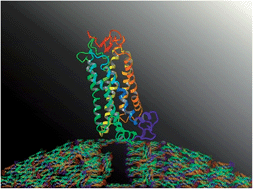Structure of the cannabinoid receptor 1: homology modeling of its inactive state and enrichment study based on CB1 antagonist docking†
Abstract
Cannabinoid receptor 1 (CB1) antagonists have potential to be used clinically to treat obesity, but there are currently no such drugs on the market. Since no X-ray crystal structure is available for CB1, considerable attempts have been made to prepare CB1 protein homology models, but in this work we propose a new CB1 inactive state model which is specific to CB1 antagonists, as validated by its enrichment performance. We first built multiple CB1 homology models. The enrichment performance of these models was then systematically examined using two datasets. A small dataset that contains 72 highly active CB1 antagonists was docked into these models. Only one of the models was able to dock all the compounds. After minimization and followed by redocking, two more models were able to dock all the 72 compounds. Next, a large dataset that contains 181 active CB1 antagonists and 3439 inactive CB1 antagonists/decoy compounds was used to assess the enrichment performance of the 3 models. One of the models was found to have much better enrichment performance than the other 2 models. This best CB1 model will be used in future virtual screening studies.


 Please wait while we load your content...
Please wait while we load your content...